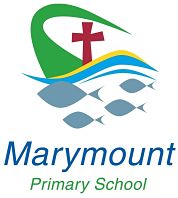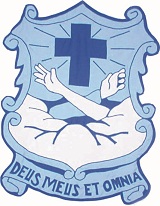Central to the logo is the Latin cross, the Christian symbol of Salvation and Christ’s victory. The cross is also an instrument of execution, a penalty reserved for lower class criminals which carried shame and disgrace. The Roman cross, consisting of a stake to which was affixed a horizontal beam, was carried by the victim to the site of the execution. It was by the cross that Christ was victorious over death, a reminder for us of God’s love and promise of eternal life.

The headland, such an integral and imposing part of the Burleigh Heads area is represented in the logo rising out from the ocean. Created 25 million years ago after the eruption of a volcano at Mt Warning, the headland has an ancient history. The Kombumerri people, the traditional owners of the land told how the headland was made by the giant Jabreen who, after a feast of honey, washed himself in the water, stood up to his full height pushing his arms toward the sky. Such was his power, the level land rose up to his fingertips and Jellurgal, or Burleigh Headland, was created.
The strip of yellow sand represents the beach around Burleigh Heads. It was the beach which transformed Burleigh Heads from a timber getter’s station to the tourist draw card it has become today. The beach, a world renowned surfing destination, is an important part of life for so many in our community.
Water is an ancient symbol for life and throughout the history of Christianity, it has also been a powerful symbol. Water is a reminder of our Baptism, the sacrament by which we become members of the Christian community and receive new life in Christ. Water is also life giving, cleansing and renewing. Like the sand of Burleigh, the water is enjoyed by so many members of our community for a swim or surf, to relax and refresh or to simply sit, watch and contemplate.
The fish is an ancient Christian symbol which may be found among ruins in catacomb graffiti as well as frescos, carvings and sculptures. These were a common symbol of Christ for the early Church and are still used today. The first letters of the Greek phrase “Jesus Christ, Son of God, Saviour” spell out the Greek word for fish—Ichthus. Numerous references are made in the Gospels to fish, from the calling of the fishermen disciples to the feeding of the multitudes with 5 loaves and 2 fishes. Jesus also called his disciples to be ‘fishers of people’. The fish represent our community and they emphasize our recognition of the value and dignity of all of creation despite our individual giftedness, beliefs and differences.
School Crest
 The Marymount Primary Crest takes its inspiration from St Francis of Assisi (1182-1226).
The Marymount Primary Crest takes its inspiration from St Francis of Assisi (1182-1226).
The Crest incorporates the Franciscan symbol of the crossed arms of Christ and St Francis. Both hands bear wounds to remind us that for St Francis, the most important thing in life was to follow Christ as closely as possible, so closely in fact that he seemed to be transformed into an image of Christ with the Stigmata.
The centre of the Crest is dominated by a cross, the symbol of Christianity, surrounded by rays of light. The cross is a reminder of salvation through the death and resurrection of Jesus which has become a central reality in our lives as Christians. Christ the light shows us how to find meaning in our lives. Surrounding these symbols are clouds covering two mountain tops – Mt Calvary, where the death of Jesus bought our salvation and Mt Alvernia, where Francis shared the passion of Jesus through the Stigmata, the five wounds of Christ. The clouds symbolise the realities of Heaven, the new life which is ours as we live out the struggles and difficulties of life supported by the strength of Christ.
The motto, “Deus Meus et Omnia” translates to My God and My All. This reminds us that no matter what we strive for, there is little we can achieve without God’s help and guidance.
© Brisbane Catholic Education, Marymount Primary School (2023)